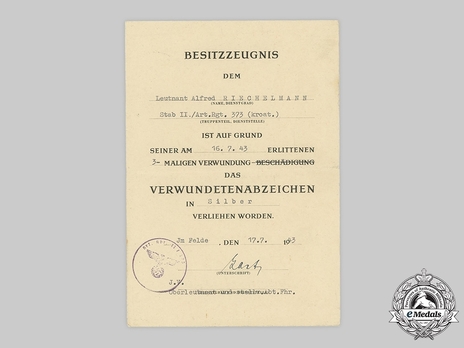Silver Wound Badge Document
CATEGORY: Document
SKU: 01.GTR.0404.102.01.D.000
Estimated market value:

Estimated market value:
Germany, Heer. A Silver Grade Wound Badge Award Document to Leutnant Alfred Riechelmann, Anti-Partisan Unit
(Verleihungsurkunde für Verwundetenabzeichen in Silber). A rare award document for a Silver Grade Wound Badge to a soldier of the 373. (Kroatische) Infanterie-Division, constructed of off-white paper stock with black ink, named to Leutnant Alfred Riechelmann, Stab II., Artillerie-Regiment 373, issued on 17 July 1943 for three wounds suffered on 16 July 1943, measuring 140 mm (w) x 200 mm (h), with a central folding crease, in overall extremely fine condition.
Originally established during the First World War, Adolf Hitler re-instituted the Badge during the 1939 Polish Campaign. Rather than simply reinstituting the World War I Naval Wound Badge, Hitler chose to combine the Army and Navy types into one award.
The 1st Pattern of the wound badge is identical to the Legion Condor Wound Badge, and it was awarded between September 1, 1939-1940. The 1st Pattern is also known as the "Legion Condor Type".
The badge was awarded in three classes, with the number of wounds suffered in hostile action determining the grade. The Gold Badge was awarded for 5 or more wounds, the Silver for 3 to 4 wounds and the Black for 1 or 2 wounds.
The Badge could be awarded to members of any military or paramilitary organization, provided that the candidate met the requirements. The loss of a limb or eyesight during battle automatically resulted in the individual receiving a silver grade. Death or complete disability entitled a soldier to a gold grade, which the family would receive in case of death. Frostbite was the only non-combative wound, which would entitle a soldier to a badge.
In 1943, civilians working in war-related industries became eligible to receive Wound Badges, as they were often exposed to dangerous conditions in their work environments. As such, civilians working in military related occupations near the front lines or in destroyed cities or factories were eligible to receive the badge.

Comments
Sign in to comment and reply.


Scroll Top